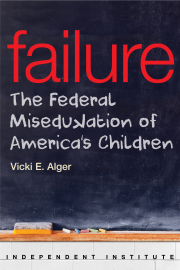The U.S. Department of Education opened its doors 36 years ago. Proponents of its creation promised improved efficiency and higher student achievement. Instead, federal spending has soared and student achievement has barely budged.
Clearly, Washington doesn’t know best, and it’s time for federal authorities to butt out of America’s schools and put parents and their locally elected boards back in charge.
The longest running nationally representative assessment of American student achievement is the National Assessment of Educational Progress, the results of which are known as the Nation’s Report Card.
Long-term trend results in both math and reading are reported on a scale of zero to 500. Students who score 300 or above can solve moderately complex math problems and understand relatively complicated reading materials.
Among 17-year-olds, typically high school seniors, the long-term performance in NAEP math has increased only slightly over decades, from 52 percent of students scoring 300 or above in 1978 to 60 percent faring as well in 2012, the latest year for which results are available.
The long-term reading performance of 17-year-olds has remained flat, with just 39 percent of students scoring 300 or above in both 1971 and 2012.
Over the same period, federal appropriations for elementary and high school education increased more than 140 percent, from $33.2 billion in 1971 to $80 billion in 2012. Student enrollment, meanwhile, increased only 9 percent, from 45.6 million in 1971 to 49.8 million in 2012.
Back in 1866, when the idea of a national education department was first being debated in Congress, Rep. Samuel J. Randall, D-Pa., predicted that it would amount to “a bureau at an extravagant rate of pay, and an undue number of clerks collecting statistics ... (that) does not propose to teach a single child ... its A, B, C’s.”
History proves Randall was right.
We were promised that illiteracy would be eliminated by 1984. We were promised that high school graduation rates would reach 90 percent by the year 2000 and that American students would be global leaders in math and science. And we were promised that by 2014 all students would be proficient in reading and math. None of this has happened.
Rather than learning from these broken promises, Congress continues to tinker with ineffective and costly federal education programs.
It’s time to end the U.S. Department of Education and put the real experts—parents—back in charge of their children’s education.
Parents, regardless of their incomes or addresses, are choosing their children’s public, charter, private and online schools in a significant and growing majority of states. More than 1.7 million students are now home-schooled, with that figure increasing 62 percent in the past decade.
Research shows that when parents have more choices in education, both students and schools benefit, and do so at a fraction of the cost of top-heavy federal programs. The resulting competition for students and their associated funding puts powerful pressure on schools to improve.
Little wonder that some seven out of 10 likely voters believe competition improves public schools and support greater parental choice, particularly education savings accounts, or ESAs.
First enacted in Arizona in 2011, and four more states since then, such savings accounts put parents in charge of their children’s education funding, allowing them to customize the services that best meet their children’s needs.
Any leftover funds remain in students’ ESAs for future expenses, including college tuition. Regular ESA expenditure audits by state education agencies provide unparalleled levels of public transparency and accountability.
Instead of funneling money through the D.C. bureaucracy, we should be funding American students directly through ESAs.
Until we put the real experts—parents and their locally elected representatives—back in charge of education, we can expect more overpromising and under-delivering from the U.S. Department of Education.









